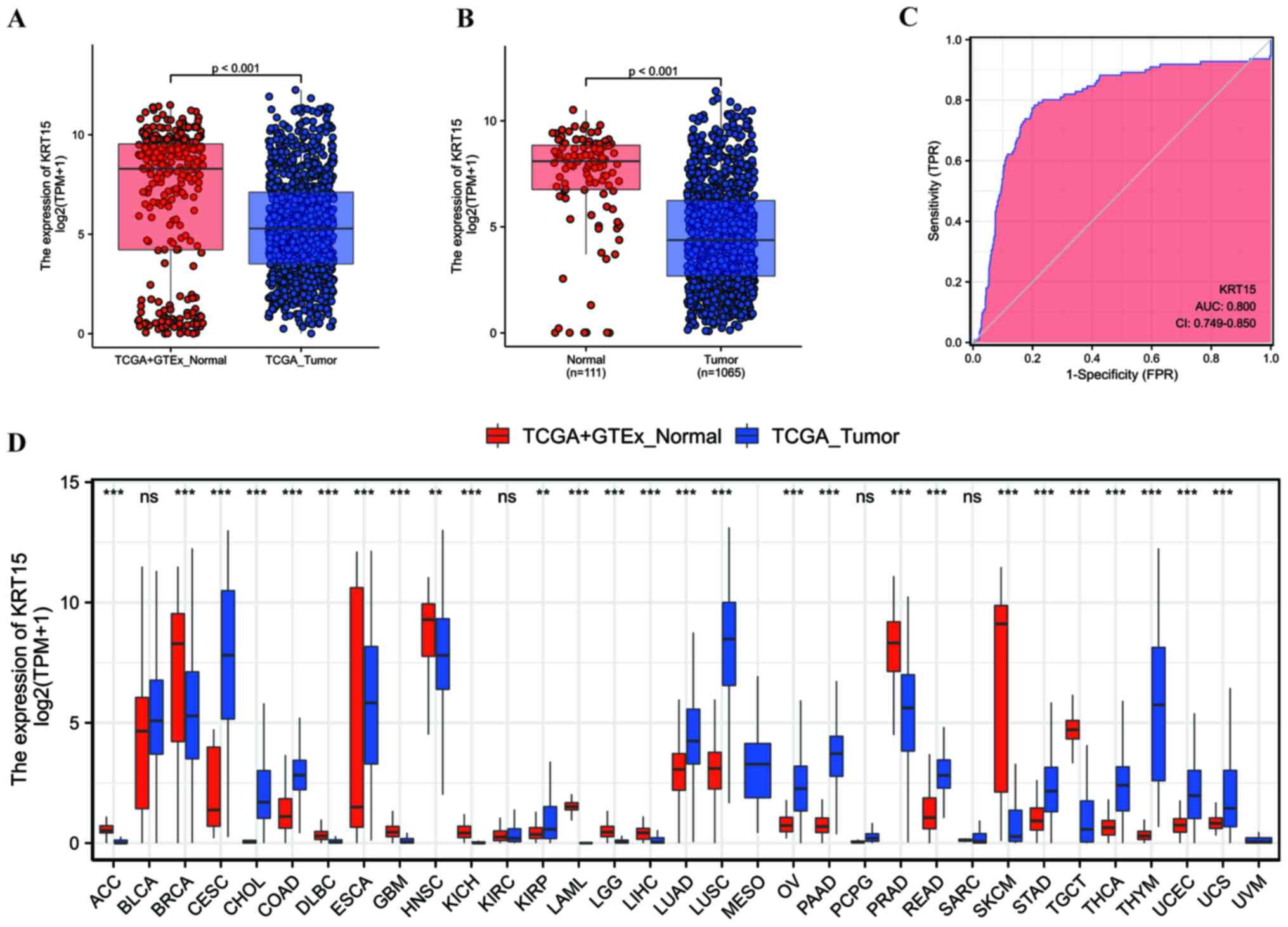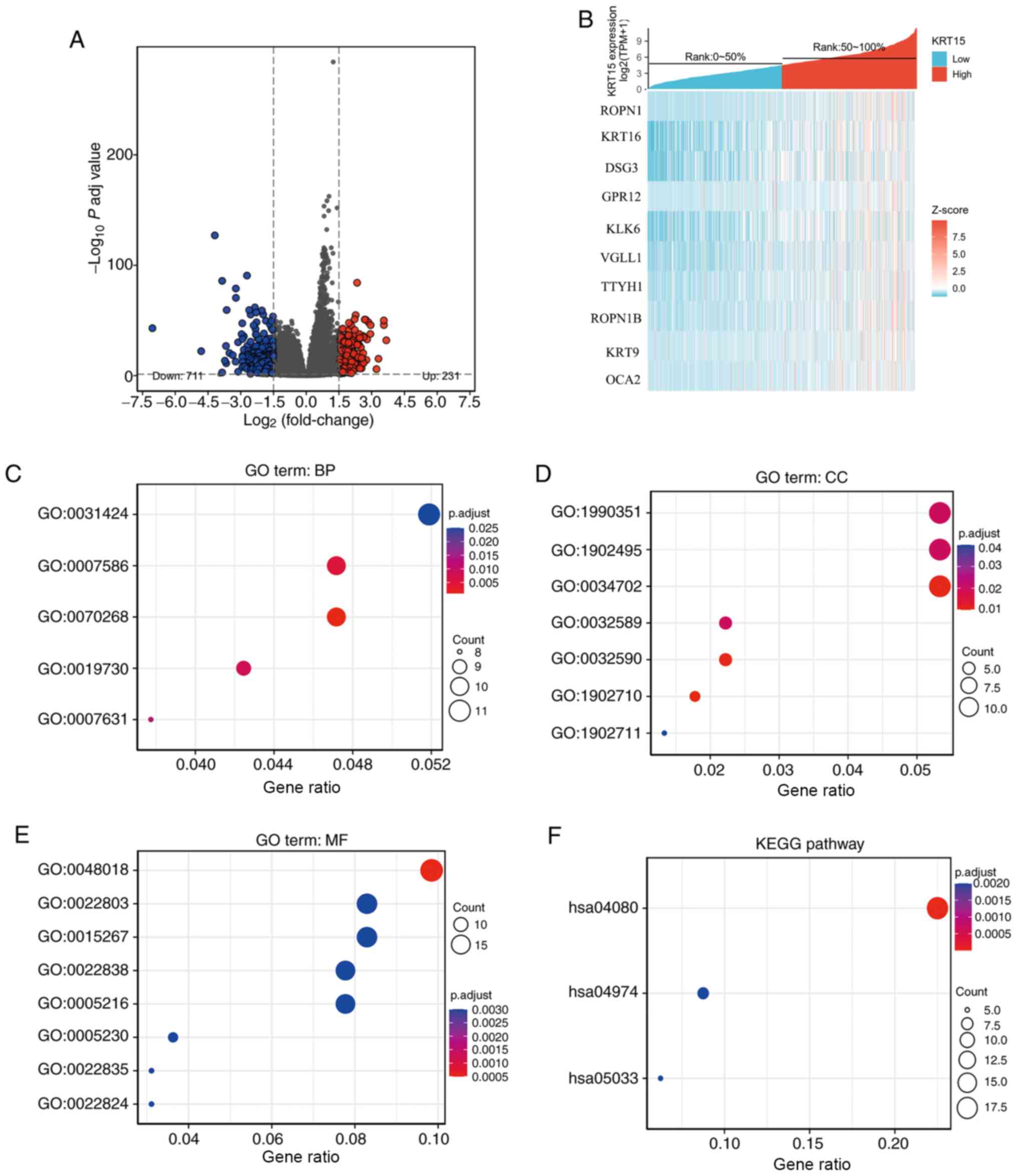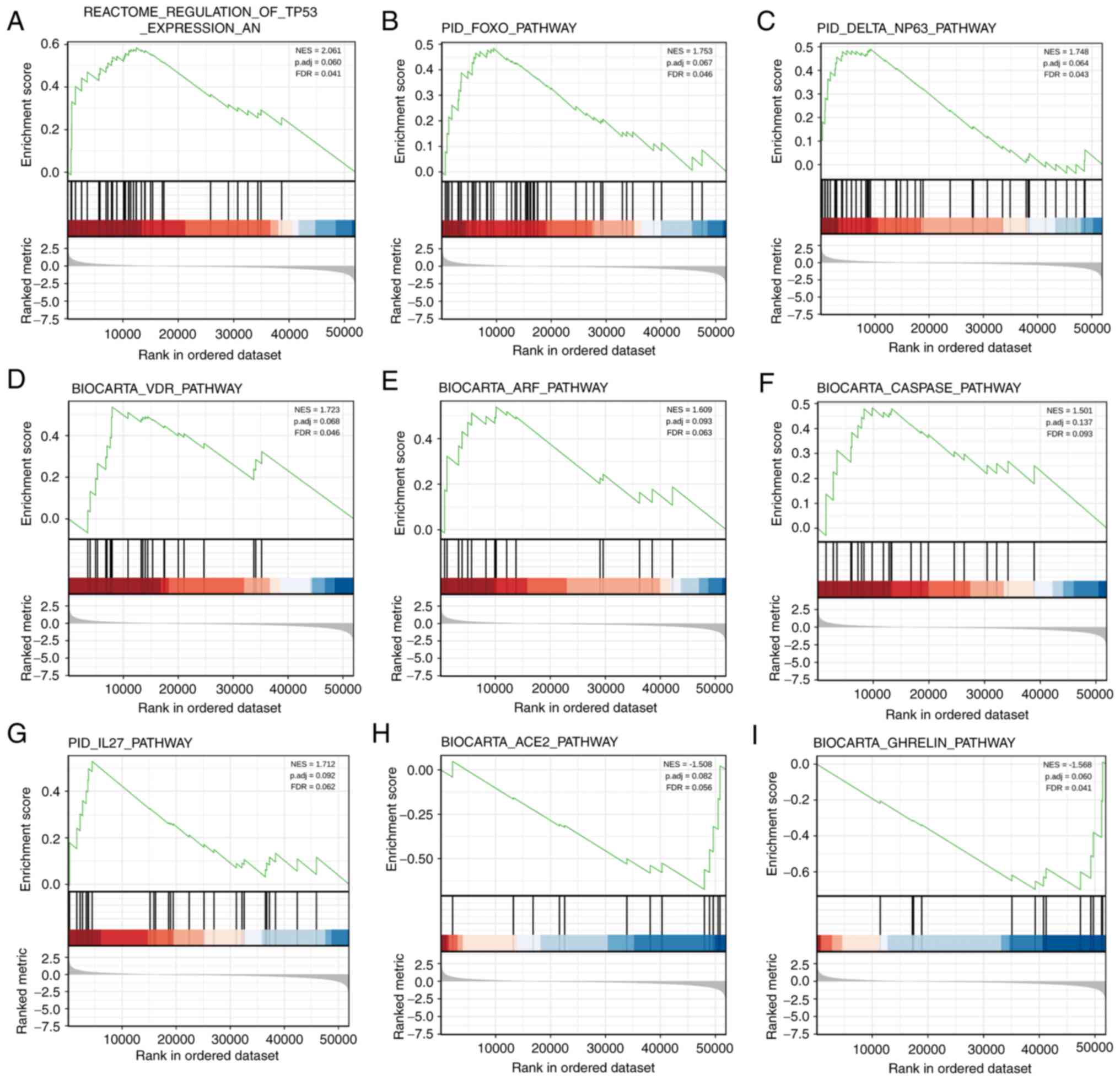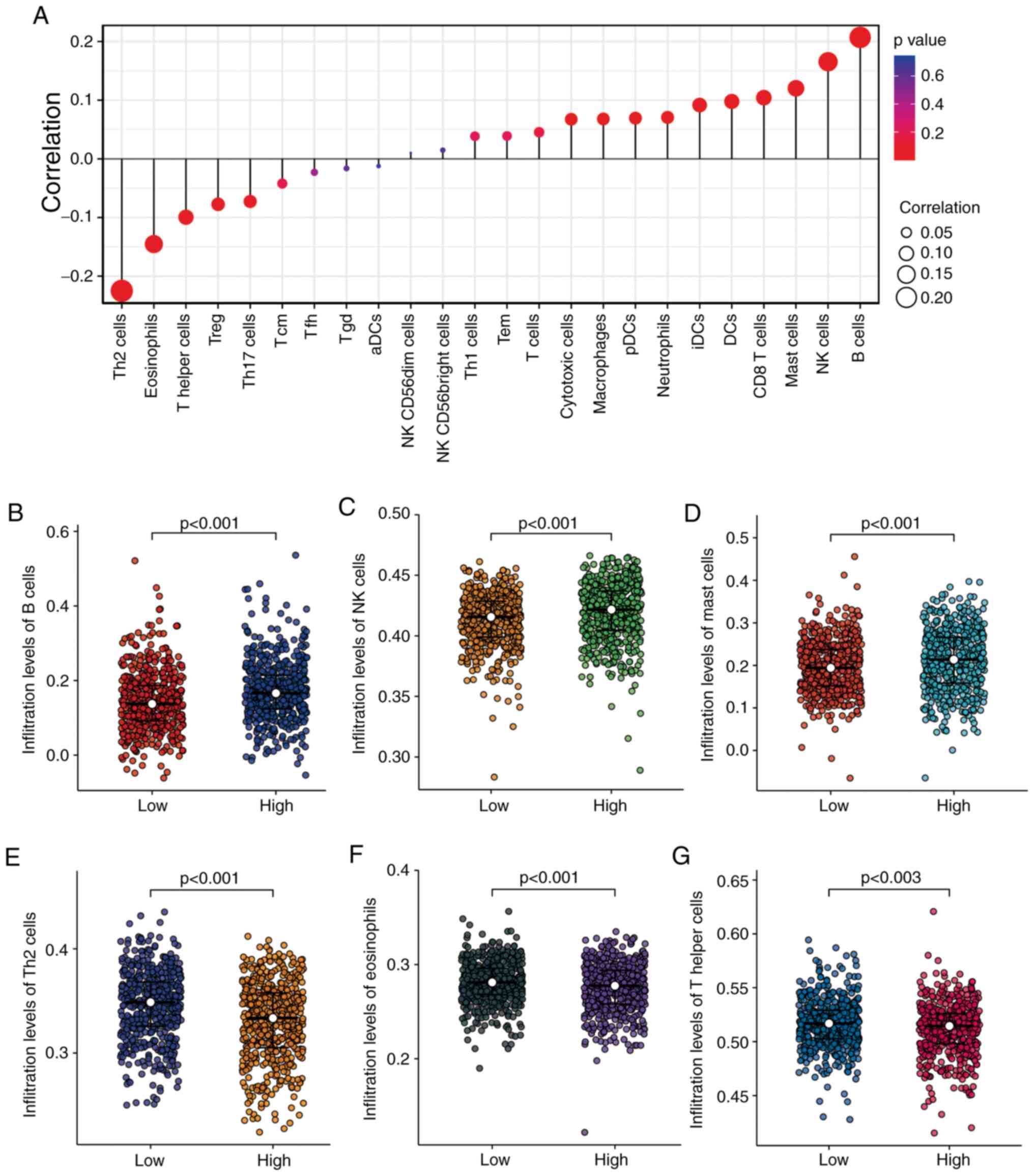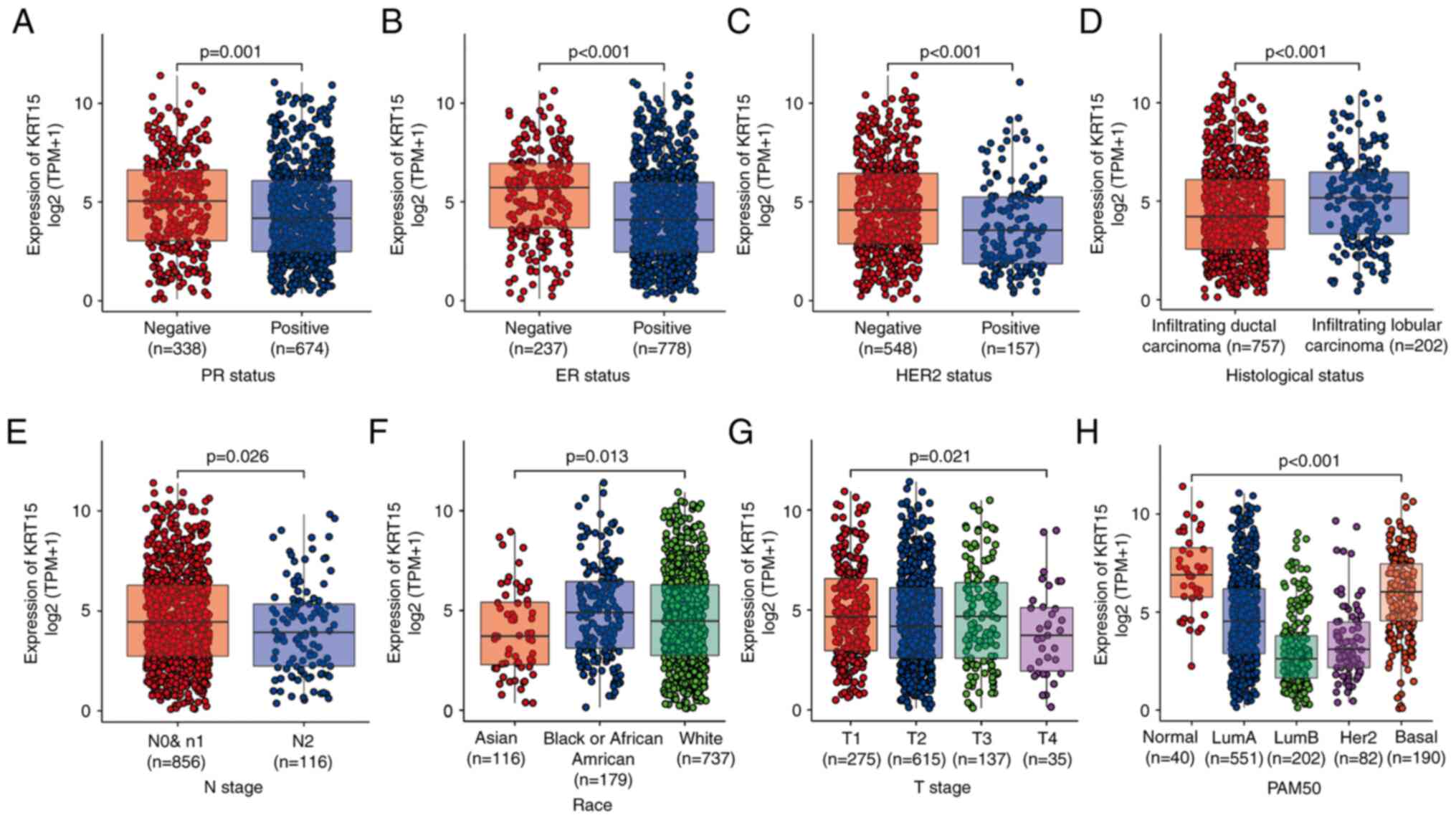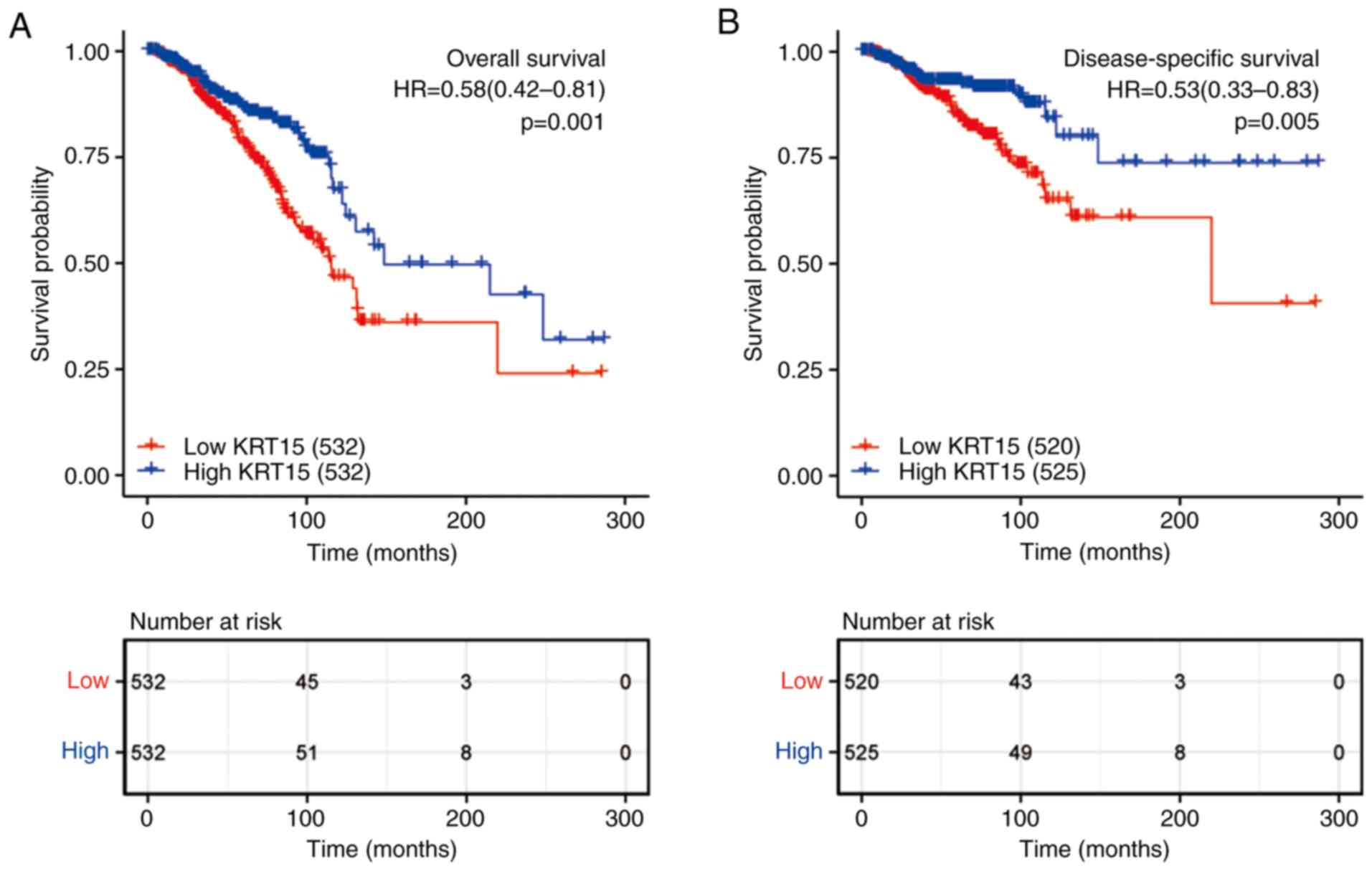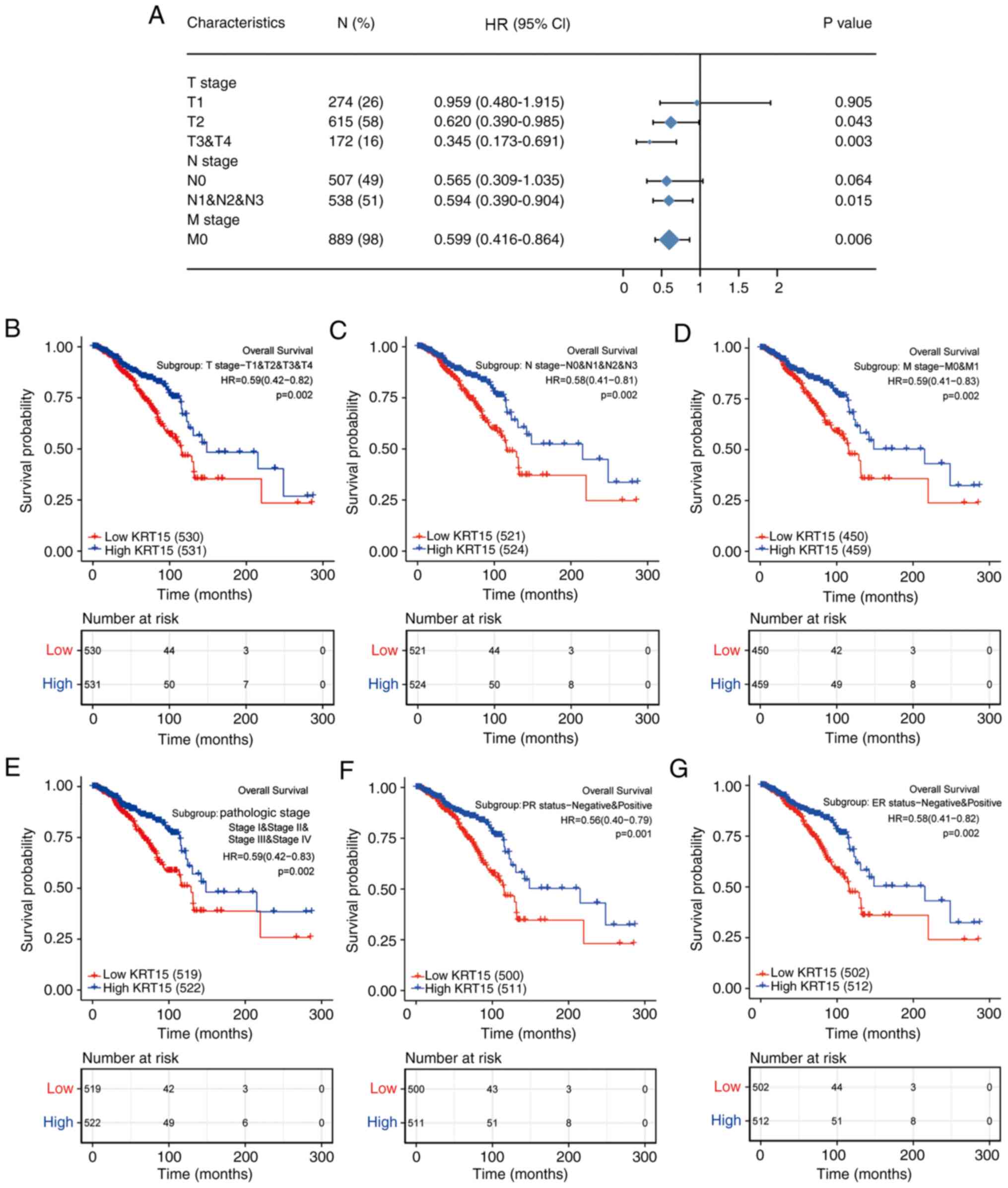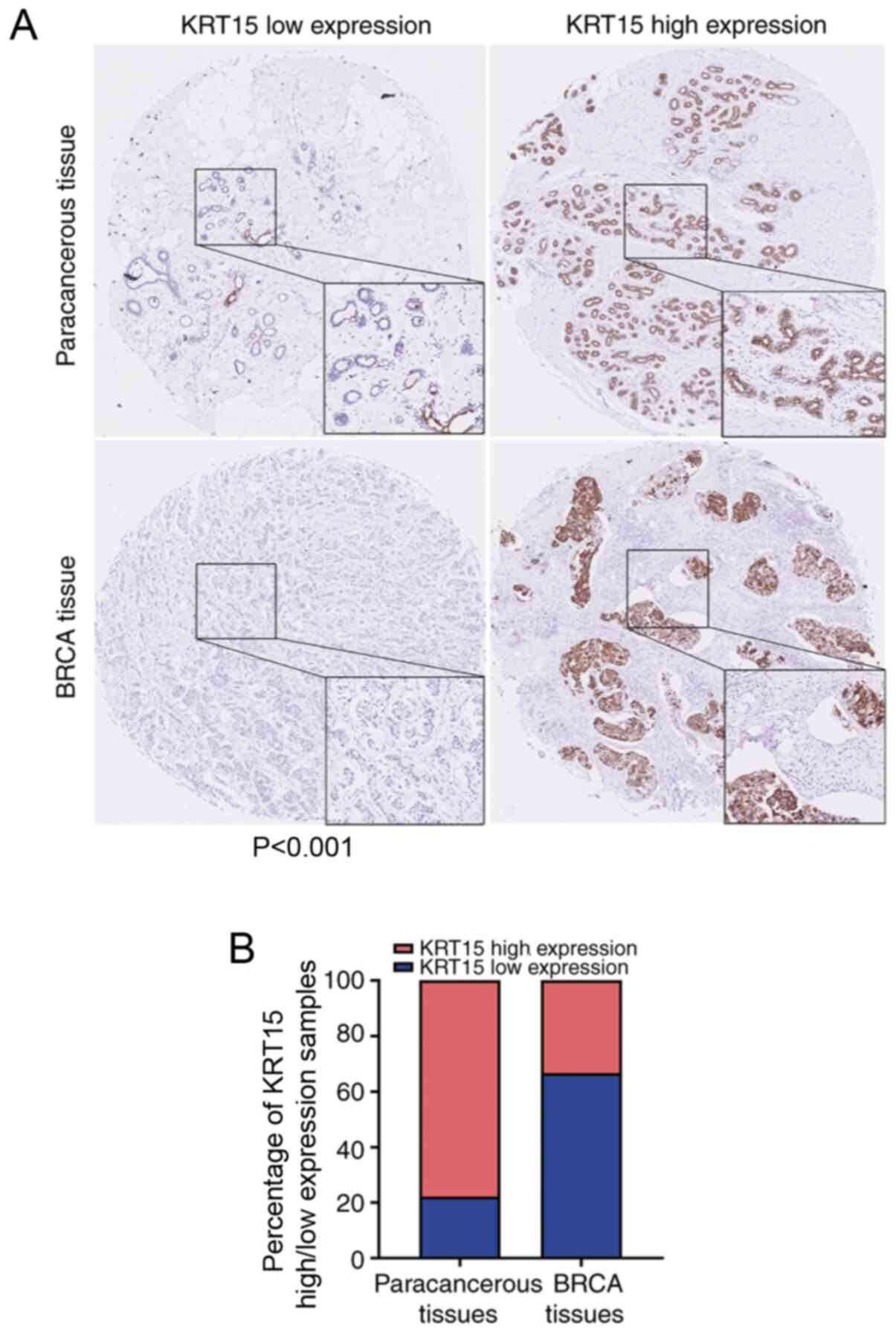|
1
|
Siegel RL, Miller KD and Jemal A: Cancer
statistics, 2019. CA Cancer J Clin. 69:7–34. 2019.PubMed/NCBI View Article : Google Scholar
|
|
2
|
Malvezzi M, Bertuccio P, Levi F, La
Vecchia C and Negri E: European cancer mortality predictions for
the year 2013. Ann Oncol. 24:792–800. 2013.PubMed/NCBI View Article : Google Scholar
|
|
3
|
Polyak K: Heterogeneity in breast cancer.
J Clin Invest. 121:3786–3788. 2011.PubMed/NCBI View
Article : Google Scholar
|
|
4
|
Klimczak M, Biecek P, Zylicz A and Zylicz
M: Heat shock proteins create a signature to predict the clinical
outcome in breast cancer. Sci Rep. 9(7507)2019.PubMed/NCBI View Article : Google Scholar
|
|
5
|
Azizi M, Ghourchian H, Yazdian F,
Bagherifam S, Bekhradnia S and Nyström B: Anti-cancerous effect of
albumin coated silver nanoparticles on MDA-MB 231 human breast
cancer cell line. Sci Rep. 7(5178)2017.PubMed/NCBI View Article : Google Scholar
|
|
6
|
Wang J, Yin H, Panandikar A, Gandhi V and
Sen S: Elevated cyclin A associated kinase activity promotes
sensitivity of metastatic human cancer cells to DNA antimetabolite
drug. Int J Oncol. 47:782–790. 2015.PubMed/NCBI View Article : Google Scholar
|
|
7
|
Masica DL and Karchin R: Correlation of
somatic mutation and expression identifies genes important in human
glioblastoma progression and survival. Cancer Res. 71:4550–4561.
2011.PubMed/NCBI View Article : Google Scholar
|
|
8
|
Liu Y, Lyle S, Yang Z and Cotsarelis G:
Keratin 15 promoter targets putative epithelial stem cells in the
hair follicle bulge. J Invest Dermatol. 121:963–968.
2003.PubMed/NCBI View Article : Google Scholar
|
|
9
|
Nagosa S, Leesch F, Putin D, Bhattacharya
S, Altshuler A, Serror L, Amitai-Lange A, Nasser W, Aberdam E,
Rouleau M, et al: microRNA-184 induces a commitment switch to
epidermal differentiation. Stem Cell Reports. 9:1991–2004.
2017.PubMed/NCBI View Article : Google Scholar
|
|
10
|
Sanchez-Palencia A, Gomez-Morales M,
Gomez-Capilla JA, Pedraza V, Boyero L, Rosell R and Fárez-Vidal ME:
Gene expression profiling reveals novel biomarkers in nonsmall cell
lung cancer. Int J Cancer. 129:355–364. 2011.PubMed/NCBI View Article : Google Scholar
|
|
11
|
Rao X, Wang J, Song HM, Deng B and Li JG:
KRT15 overexpression predicts poor prognosis in colorectal cancer.
Neoplasma. 67:410–414. 2020.PubMed/NCBI View Article : Google Scholar
|
|
12
|
Seykora JT and Cotsarelis G: Keratin
15-positive stem cells give rise to basal cell carcinomas in
irradiated Ptch1+/- mice. Cancer Cell. 19:5–6.
2011.PubMed/NCBI View Article : Google Scholar
|
|
13
|
Moon H, Zhu J, Donahue LR, Choi E and
White AC: Krt5+/Krt15+ foregut basal
progenitors give rise to cyclooxygenase-2-dependent tumours in
response to gastric acid stress. Nat Commun.
10(2225)2019.PubMed/NCBI View Article : Google Scholar
|
|
14
|
Vivian J, Rao AA, Nothaft FA, Ketchum C,
Armstrong J, Novak A, Pfeil J, Narkizian J, Deran AD,
Musselman-Brown A, et al: Toil enables reproducible, open source,
big biomedical data analyses. Nat Biotechnol. 35:314–316.
2017.PubMed/NCBI View
Article : Google Scholar
|
|
15
|
Robin X, Turck N, Hainard A, Tiberti N,
Lisacek F, Sanchez JC and Müller M: pROC: An open-source package
for R and S+ to analyze and compare ROC curves. BMC Bioinformatics.
12(77)2011.PubMed/NCBI View Article : Google Scholar
|
|
16
|
Love MI, Huber W and Anders S: Moderated
estimation of fold change and dispersion for RNA-seq data with
DESeq2. Genome Biol. 15(550)2014.PubMed/NCBI View Article : Google Scholar
|
|
17
|
Yu G, Wang LG, Han Y and He QY:
clusterProfiler: An R package for comparing biological themes among
gene clusters. OMICS. 16:284–287. 2012.PubMed/NCBI View Article : Google Scholar
|
|
18
|
Subramanian A, Tamayo P, Mootha VK,
Mukherjee S, Ebert BL, Gillette MA, Paulovich A, Pomeroy SL, Golub
TR, Lander ES and Mesirov JP: Gene set enrichment analysis: A
knowledge-based approach for interpreting genome-wide expression
profiles. Proc Natl Acad Sci USA. 102:15545–15550. 2005.PubMed/NCBI View Article : Google Scholar
|
|
19
|
Bindea G, Mlecnik B, Tosolini M,
Kirilovsky A, Waldner M, Obenauf AC, Angell H, Fredriksen T,
Lafontaine L, Berger A, et al: Spatiotemporal dynamics of
intratumoral immune cells reveal the immune landscape in human
cancer. Immunity. 39:782–795. 2013.PubMed/NCBI View Article : Google Scholar
|
|
20
|
Hänzelmann S, Castelo R and Guinney J:
GSVA: Gene set variation analysis for microarray and RNA-seq data.
BMC Bioinformatics. 14(7)2013.PubMed/NCBI View Article : Google Scholar
|
|
21
|
Sinicrope FA, Ruan SB, Cleary KR, Stephens
LC, Lee JJ and Levin B: bcl-2 and p53 oncoprotein expression during
colorectal tumorigenesis. Cancer Res. 55:237–241. 1995.PubMed/NCBI
|
|
22
|
Chu PG and Weiss LM: Keratin expression in
human tissues and neoplasms. Histopathology. 40:403–439.
2002.PubMed/NCBI View Article : Google Scholar
|
|
23
|
Giroux V, Stephan J, Chatterji P, Rhoades
B, Wileyto EP, Klein-Szanto AJ, Lengner CJ, Hamilton KE and Rustgi
AK: Mouse intestinal Krt15+ crypt cells are radio-resistant
and tumor initiating. Stem Cell Reports. 10:1947–1958.
2018.PubMed/NCBI View Article : Google Scholar
|
|
24
|
Morris RJ, Liu Y, Marles L, Yang Z,
Trempus C, Li S, Lin JS, Sawicki JA and Cotsarelis G: Capturing and
profiling adult hair follicle stem cells. Nat Biotechnol.
22:411–417. 2004.PubMed/NCBI View
Article : Google Scholar
|
|
25
|
Depianto D, Kerns ML, Dlugosz AA and
Coulombe PA: Keratin 17 promotes epithelial proliferation and tumor
growth by polarizing the immune response in skin. Nat Genet.
42:910–914. 2010.PubMed/NCBI View
Article : Google Scholar
|
|
26
|
Li S, Park H, Trempus CS, Gordon D, Liu Y,
Cotsarelis G and Morris RJ: A keratin 15 containing stem cell
population from the hair follicle contributes to squamous papilloma
development in the mouse. Mol Carcinog. 52:751–759. 2013.PubMed/NCBI View Article : Google Scholar
|
|
27
|
Wang GY, Wang J, Mancianti ML and Epstein
EH Jr: Basal cell carcinomas arise from hair follicle stem cells in
Ptch1+/- mice. Cancer Cell. 19:114–124.
2011.PubMed/NCBI View Article : Google Scholar
|
|
28
|
Sadraei NH, Shi I, Duan ZH and Shi T:
Aberrant signaling pathways in squamous cell lung carcinoma. Clin
Cancer Res. 18 (3 Suppl)(A16)2012.
|
|
29
|
Tai G, Ranjzad P, Marriage F, Rehman S,
Denley H, Dixon J, Mitchell K, Day PJ and Woolf AS: Cytokeratin 15
marks basal epithelia in developing ureters and is upregulated in a
subset of urothelial cell carcinomas. PLoS One.
8(e81167)2013.PubMed/NCBI View Article : Google Scholar
|
|
30
|
Zhang C, Liang Y, Ma MH, Wu KZ and Dai DQ:
KRT15, INHBA, MATN3, and AGT are aberrantly methylated and
differentially expressed in gastric cancer and associated with
prognosis. Pathol Res Pract. 215:893–899. 2019.PubMed/NCBI View Article : Google Scholar
|
|
31
|
Evangelista MT and North JP: Comparative
analysis of cytokeratin 15, TDAG51, cytokeratin 20 and androgen
receptor in sclerosing adnexal neoplasms and variants of basal cell
carcinoma. J Cutan Pathol. 42:824–831. 2015.PubMed/NCBI View Article : Google Scholar
|
|
32
|
Weisfelner ME and Gottlieb AB: The role of
apoptosis in human epidermal keratinocytes. J Drugs Dermatol.
2:385–391. 2003.PubMed/NCBI
|
|
33
|
Elias PM: Stratum corneum defensive
functions: An integrated view. J Invest Dermatol. 125:183–200.
2005.PubMed/NCBI View Article : Google Scholar
|
|
34
|
Lippens S, Denecker G, Ovaere P,
Vandenabeele P and Declercq W: Death penalty for keratinocytes:
Apoptosis versus cornification. Cell Death Differ. 12 (Suppl
2):S1497–S1508. 2005.PubMed/NCBI View Article : Google Scholar
|
|
35
|
Moody CA and Laimins LA: Human
papillomavirus oncoproteins: Pathways to transformation. Nat Rev
Cancer. 10:550–560. 2010.PubMed/NCBI View Article : Google Scholar
|
|
36
|
Yi R, Poy MN, Stoffel M and Fuchs E: A
skin microRNA promotes differentiation by repressing ‘stemness’.
Nature. 452:225–229. 2008.PubMed/NCBI View Article : Google Scholar
|
|
37
|
Lane DP: Cancer p53, guardian of the
genome. Nature. 358:15–16. 1992.PubMed/NCBI View Article : Google Scholar
|
|
38
|
Kandoth C, McLellan MD, Vandin F, Ye K,
Niu B, Lu C, Xie M, Zhang Q, McMichael JF, Wyczalkowski MA, et al:
Mutational landscape and significance across 12 major cancer types.
Nature. 502:333–339. 2013.PubMed/NCBI View Article : Google Scholar
|
|
39
|
Farhan M, Wang H, Gaur U, Little PJ, Xu J
and Zheng W: FOXO signaling pathways as therapeutic targets in
cancer. Int J Biol Sci. 13:815–827. 2017.PubMed/NCBI View Article : Google Scholar
|
|
40
|
Napoli M and Flores ER: The family that
eats together stays together: New p53 family transcriptional
targets in autophagy. Genes Dev. 27:971–974. 2013.PubMed/NCBI View Article : Google Scholar
|
|
41
|
Napoli M and Flores ER: The p53 family
orchestrates the regulation of metabolism: Physiological regulation
and implications for cancer therapy. Br J Cancer. 116:149–155.
2017.PubMed/NCBI View Article : Google Scholar
|
|
42
|
Prokhorova EA, Zamaraev AV, Kopeina GS,
Zhivotovsky B and Lavrik IN: Role of the nucleus in apoptosis:
Signaling and execution. Cell Mol Life Sci. 72:4593–4612.
2015.PubMed/NCBI View Article : Google Scholar
|
|
43
|
Vaughan-Shaw PG, O'Sullivan F, Farrington
SM, Theodoratou E, Campbell H, Dunlop MG and Zgaga L: The impact of
vitamin D pathway genetic variation and circulating
25-hydroxyvitamin D on cancer outcome: Systematic review and
meta-analysis. Br J Cancer. 116:1092–1110. 2017.PubMed/NCBI View Article : Google Scholar
|
|
44
|
Ferrer-Mayorga G, Gómez-López G,
Barbáchano A, Fernández-Barral A, Peña C, Pisano DG, Cantero R,
Rojo F, Muñoz A and Larriba MJ: Vitamin D receptor expression and
associated gene signature in tumour stromal fibroblasts predict
clinical outcome in colorectal cancer. Gut. 66:1449–1462.
2017.PubMed/NCBI View Article : Google Scholar
|
|
45
|
Carrasco-Garcia E, Moreno M, Moreno-Cugnon
L and Matheu A: Increased Arf/p53 activity in stem cells, aging and
cancer. Aging Cell. 16:219–225. 2017.PubMed/NCBI View Article : Google Scholar
|
|
46
|
Strasser A, O'Connor L and Dixit VM:
Apoptosis signaling. Annu Rev Biochem. 69:217–245. 2000.PubMed/NCBI View Article : Google Scholar
|
|
47
|
Wang Q and Liu J: Regulation and immune
function of IL-27. Adv Exp Med Biol. 941:191–211. 2016.PubMed/NCBI View Article : Google Scholar
|
|
48
|
Dai YJ, Hu F, Li H, Huang HY, Wang DW and
Liang Y: A profiling analysis on the receptor ACE2 expression
reveals the potential risk of different type of cancers vulnerable
to SARS-CoV-2 infection. Ann Transl Med. 8(481)2020.PubMed/NCBI View Article : Google Scholar
|
|
49
|
Lin TC, Yeh YM, Fan WL, Chang YC, Lin WM,
Yang TY and Hsiao M: Ghrelin upregulates oncogenic Aurora A to
promote renal cell carcinoma invasion. Cancers (Basel).
11(303)2019.PubMed/NCBI View Article : Google Scholar
|
|
50
|
Zhang J and Xie T: Ghrelin inhibits
cisplatin-induced MDA-MB-231 breast cancer cell apoptosis via
PI3K/Akt/mTOR signaling. Exp Ther Med. 19:1633–1640.
2020.PubMed/NCBI View Article : Google Scholar
|
|
51
|
Orange JS: Natural killer cell deficiency.
J Allergy Clin Immunol. 132:515–525. 2013.PubMed/NCBI View Article : Google Scholar
|
|
52
|
Smyth MJ, Crowe NY and Godfrey DI: NK
cells and NKT cells collaborate in host protection from
methylcholanthrene-induced fibrosarcoma. Int Immunol. 13:459–463.
2001.PubMed/NCBI View Article : Google Scholar
|
|
53
|
Smyth MJ, Thia KY, Street SE, Cretney E,
Trapani JA, Taniguchi M, Kawano T, Pelikan SB, Crowe NY and Godfrey
DI: Differential tumor surveillance by natural killer (NK) and NKT
cells. J Exp Med. 191:661–668. 2000.PubMed/NCBI View Article : Google Scholar
|
|
54
|
Caligiuri MA: Human natural killer cells.
Blood. 112:461–469. 2008.PubMed/NCBI View Article : Google Scholar
|
|
55
|
Müller-Hermelink N, Braumüller H, Pichler
B, Wieder T, Mailhammer R, Schaak K, Ghoreschi K, Yazdi A, Haubner
R, Sander CA, et al: TNFR1 signaling and IFN-gamma signaling
determine whether T cells induce tumor dormancy or promote
multistage carcinogenesis. Cancer Cell. 13:507–518. 2008.PubMed/NCBI View Article : Google Scholar
|
|
56
|
Böttcher JP, Bonavita E, Chakravarty P,
Blees H, Cabeza-Cabrerizo M, Sammicheli S, Rogers NC, Sahai E,
Zelenay S, Reis E and Sousa C: NK cells stimulate recruitment of
cDC1 into the tumor microenvironment promoting cancer immune
control. Cell. 172:1022–1037.e14. 2018.PubMed/NCBI View Article : Google Scholar
|
|
57
|
Fannon M, Forsten-Williams K, Dowd CJ,
Freedman DA, Folkman J and Nugent MA: Binding inhibition of
angiogenic factors by heparan sulfate proteoglycans in aqueous
humor: Potential mechanism for maintenance of an avascular
environment. FASEB J. 17:902–904. 2003.PubMed/NCBI View Article : Google Scholar
|
|
58
|
Gooch JL, Lee AV and Yee D: Interleukin 4
inhibits growth and induces apoptosis in human breast cancer cells.
Cancer Res. 58:4199–4205. 1998.PubMed/NCBI
|
|
59
|
Bruno TC: New predictors for immunotherapy
responses sharpen our view of the tumour microenvironment. Nature.
577:474–476. 2020.PubMed/NCBI View Article : Google Scholar
|
|
60
|
Petitprez F, de Reyniès A, Keung EZ, Chen
TW, Sun CM, Calderaro J, Jeng YM, Hsiao LP, Lacroix L, Bougoüin A,
et al: B cells are associated with survival and immunotherapy
response in sarcoma. Nature. 577:556–560. 2020.PubMed/NCBI View Article : Google Scholar
|
|
61
|
Helmink BA, Reddy SM, Gao J, Zhang S,
Basar R, Thakur R, Yizhak K, Sade-Feldman M, Blando J, Han G, et
al: B cells and tertiary lymphoid structures promote immunotherapy
response. Nature. 577:549–555. 2020.PubMed/NCBI View Article : Google Scholar
|
|
62
|
Zhu J, Yamane H and Paul WE:
Differentiation of effector CD4 T cell populations (*). Annu Rev
Immunol. 28:445–489. 2010.PubMed/NCBI View Article : Google Scholar
|
|
63
|
Aspord C, Pedroza-Gonzalez A, Gallegos M,
Tindle S, Burton EC, Su D, Marches F, Banchereau J and Palucka AK:
Breast cancer instructs dendritic cells to prime interleukin
13-secreting CD4+ T cells that facilitate tumor
development. J Exp Med. 204:1037–1047. 2007.PubMed/NCBI View Article : Google Scholar
|
|
64
|
He D, Li H, Yusuf N, Elmets CA, Li J,
Mountz JD and Xu H: IL-17 promotes tumor development through the
induction of tumor promoting microenvironments at tumor sites and
myeloid-derived suppressor cells. J Immunol. 184:2281–2288.
2010.PubMed/NCBI View Article : Google Scholar
|
|
65
|
Todaro M, Lombardo Y, Francipane MG, Alea
MP, Cammareri P, Iovino F, Di Stefano AB, Di Bernardo C, Agrusa A,
Condorelli G, et al: Apoptosis resistance in epithelial tumors is
mediated by tumor-cell-derived interleukin-4. Cell Death Differ.
15:762–772. 2008.PubMed/NCBI View Article : Google Scholar
|
|
66
|
Liu X, Mo W, Ye J, Li L, Zhang Y, Hsueh
EC, Hoft DF and Peng G: Regulatory T cells trigger effector T cell
DNA damage and senescence caused by metabolic competition. Nat
Commun. 9(249)2018.PubMed/NCBI View Article : Google Scholar
|
|
67
|
Wang L, Yi T, Kortylewski M, Pardoll DM,
Zeng D and Yu H: IL-17 can promote tumor growth through an
IL-6-Stat3 signaling pathway. J Exp Med. 206:1457–1464.
2009.PubMed/NCBI View Article : Google Scholar
|















